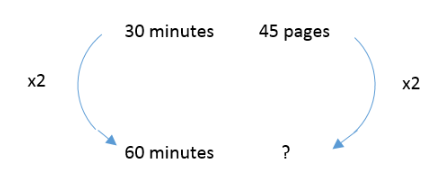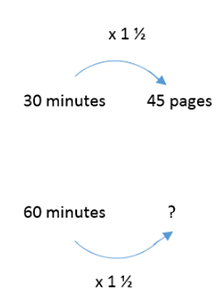1.5 Moving to abstract thinking and using pictorial representations
Proportional reasoning does not always involve physical objects, so learners need to be able to abstract their thinking about ratio and proportion.
When moving from concrete resources to more abstract thinking, it can be helpful to encourage learners to draw diagrams to support their thinking.
Activity 7 An example of a proportionality problem
If it takes Sakina 30 minutes to read 45 words, how many words could she read in 60 minutes?
Discussion
Minutes can be compared to minutes. Here 60 minutes is twice 30 minutes.
This multiplicative relationship can then be applied to the relationship between pages. This is known as a scalar comparison.
A pictorial representation of this approach is shown below.
Alternatively, pages can be compared to minutes. This is a proportional comparison.
Here, 45 is 1 times 30, and this relationship can then be related to the 60 minutes.
A pictorial representation of this approach is shown below.
Note that both approaches give the same result.
In the next section you will look at problem solving with proportional reasoning and discuss misconceptions that often arise.


